A Step Back in Time: Experience Life at the Cao Family Compound
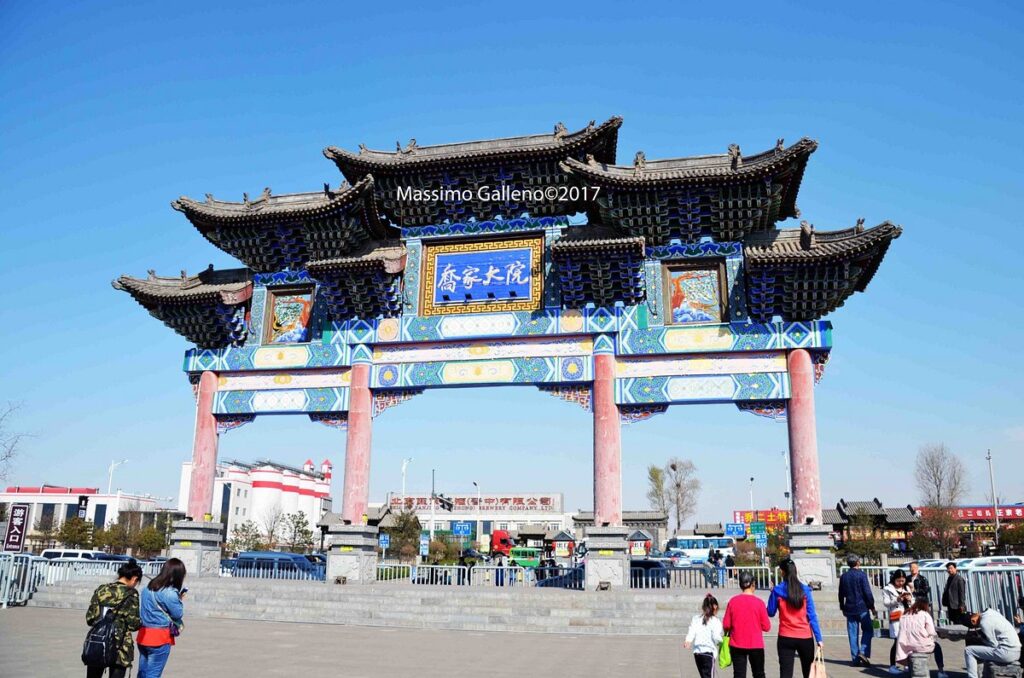
An Essential Guide to Visiting Cao Family Compound
In This Guide
- An Essential Guide to Visiting Cao Family Compound
- The Rich History and Legends of Cao Family Compound
- Main Highlights: What You Absolutely Can’t Miss
- Planning Your Visit: A Practical Guide
- Tickets: Prices, Booking, and Tips
- How to Get There: A Complete Transportation Guide
- Local Cuisine and Accommodation Nearby
- Frequently Asked Questions
- Final Thoughts on Your Trip
Nestled in the tranquil countryside of Shanxi Province, the Cao Family Compound (曹家大院) stands as a testament to the grandeur and complexity of ancient Chinese merchant life. This remarkable estate, located just a stone’s throw from the historic Pingyao Ancient City, offers visitors a window into the opulent world of one of China’s most prosperous families during the late Qing Dynasty. With its sprawling courtyards and intricately designed architecture, the compound not only showcases the architectural brilliance of the time but also encapsulates the rich tapestry of Chinese history.
As you step through the gates of the Cao Family Compound, prepare to be transported back in time. The estate, known as Sanduo Hall, symbolizes the three wishes of more fortune, longevity, and offspring—values deeply cherished in Chinese culture. Spanning over 10,638 square meters, this architectural marvel comprises three main courtyards and 277 rooms, each telling a story of the family’s rise from humble beginnings in the bean curd trade to becoming a formidable force in international commerce.
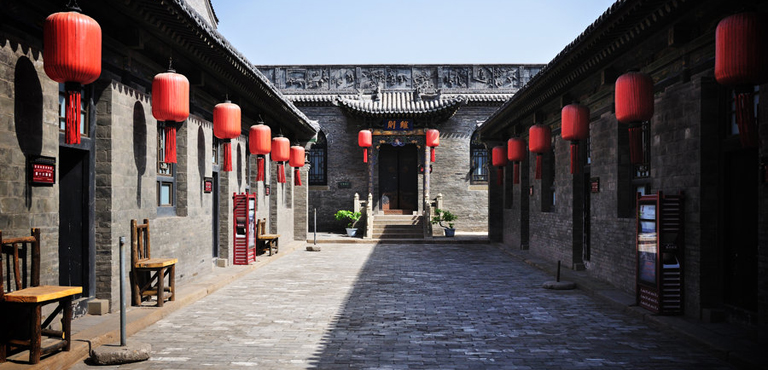
Cao Family Compound.
What to Expect
Visitors to the Cao Family Compound can explore:
- Majestic Architecture: Admire the distinct Ming and Qing Dynasty styles that characterize the compound’s structure, reflecting the family’s wealth and status.
- Cultural Treasures: Discover an extraordinary collection of artifacts, including over 400 pieces of Ming and Qing furniture, a stunning golden clock, and exquisite porcelain, each with its own story to tell.
- Rich History: Learn about the Cao family’s journey through interactive exhibits that depict their triumphs and tribulations, including the family’s ties to historical figures like Empress Dowager Cixi.
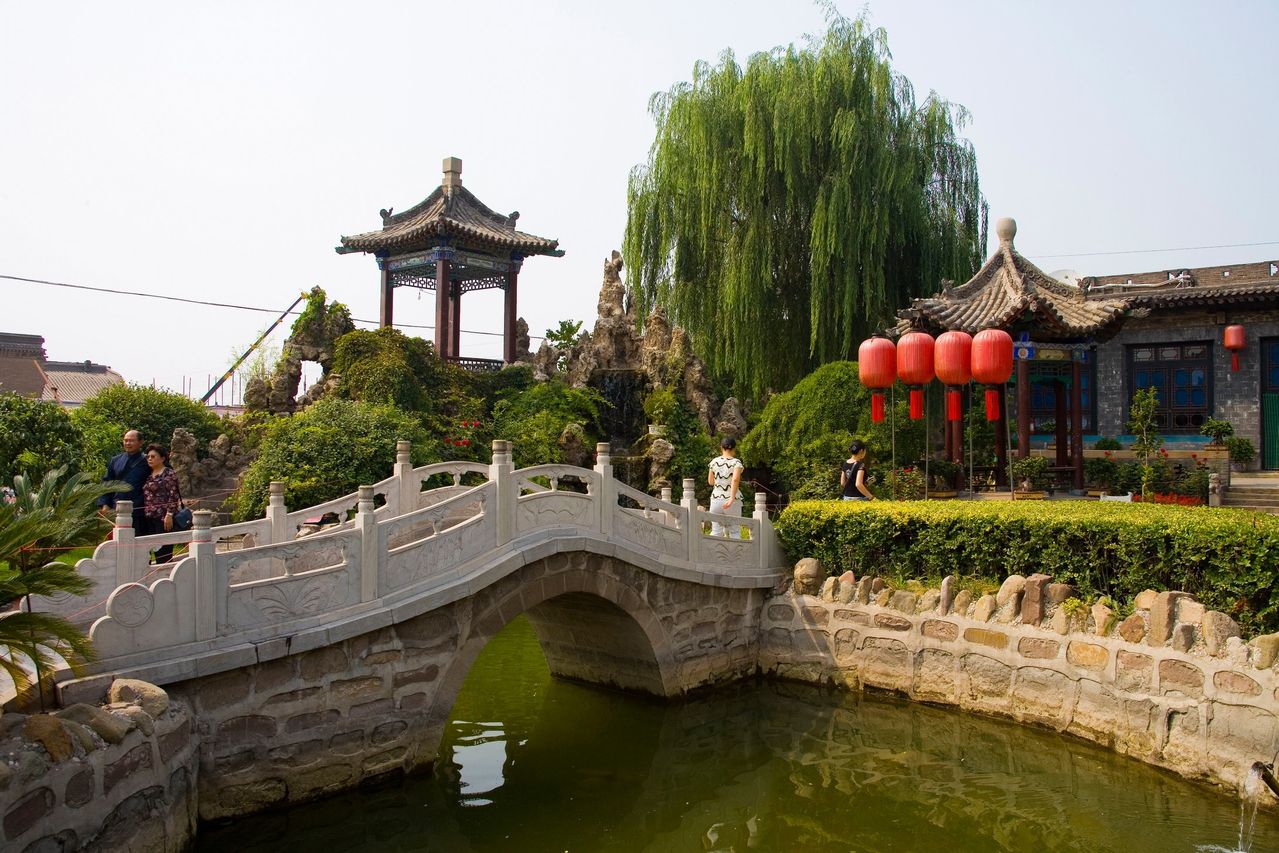
Cao Family Compound.
Whether you’re an enthusiast of history, architecture, or simply seeking an off-the-beaten-path experience in China, the Cao Family Compound promises an enlightening journey into the past. Prepare to be captivated by the stories that unfold in this grand residence, and don’t forget to take a moment to appreciate the serene beauty of its surroundings—a harmonious blend of nature and history waiting to be explored.
The Rich History and Legends of Cao Family Compound
A Journey Through Time at the Cao Family Compound
Nestled in the picturesque landscape of Shanxi Province, the Cao Family Compound (曹家大院) stands as a testament to the opulence and ingenuity of one of China’s most prominent merchant families. This architectural marvel, with its rich history and intriguing legends, offers visitors a captivating glimpse into the lives of the Cao family and the vibrant commercial culture of ancient China.

Cao Family Compound.
The Rise of the Cao Family
The Cao family began their journey in the late Ming Dynasty (1368-1644), initially trading in humble commodities such as bean curd. Through astute business practices and strategic expansions, they transformed their small enterprise into a colossal business empire during the late Qing Dynasty (1644-1911). At the peak of their power, the Caos operated over 640 firms and employed around 37,000 people, amassing a staggering wealth estimated at 12 million taels of silver—a fortune that stretched across international borders with connections in Japan, Moscow, Paris, and London.
Architectural Grandeur
Constructed over an area of 10,638 square meters, the compound is a stunning example of traditional Chinese residential architecture, embodying styles from the Ming and Qing Dynasties. The Cao Family Compound is comprised of three expansive courtyards, interlinked by three impressive 17-meter-high buildings, which together house a total of 277 rooms. This design not only reflects the aesthetic values of the time but also serves practical purposes, allowing for the family’s complex social and commercial activities.
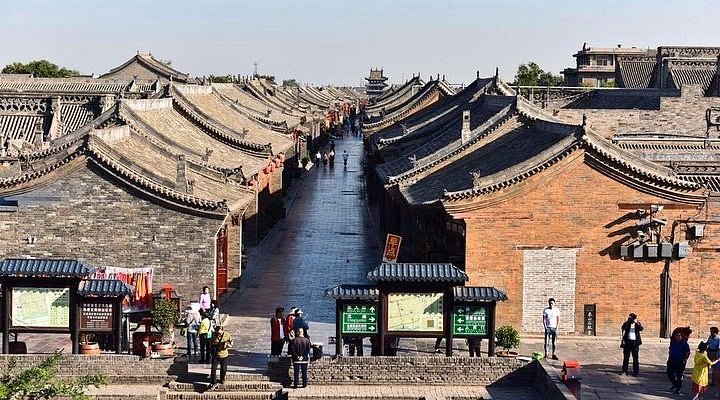
Cao Family Compound.
Known as Sanduo Hall, which translates to “Three More”—a reference to the blessings of more fortune, longevity, and children—the compound is a space where every beam and brick tells a story of prosperity and family legacy.
Cultural Treasures
Inside the Cao Family Compound, visitors are treated to a treasure trove of cultural relics. The Sanduo Hall is adorned with hundreds of artworks and artifacts that encapsulate the essence of the Cao family’s life and times. Among the most remarkable items is a magnificent folding screen made of 92 pieces of precious natural marble, inscribed with characters wishing longevity and imparting wisdom to future generations.
Another astonishing piece is the exquisite shell mirror, which is said to bring good fortune. This mirror displays different colors depending on the angle from which it is viewed, with hues like red, pink, and yellow representing prosperity, love, and wealth, respectively. The collection also boasts nearly 2,000 pieces of stoneware, providing a tactile connection to the Ming and Qing Dynasties.
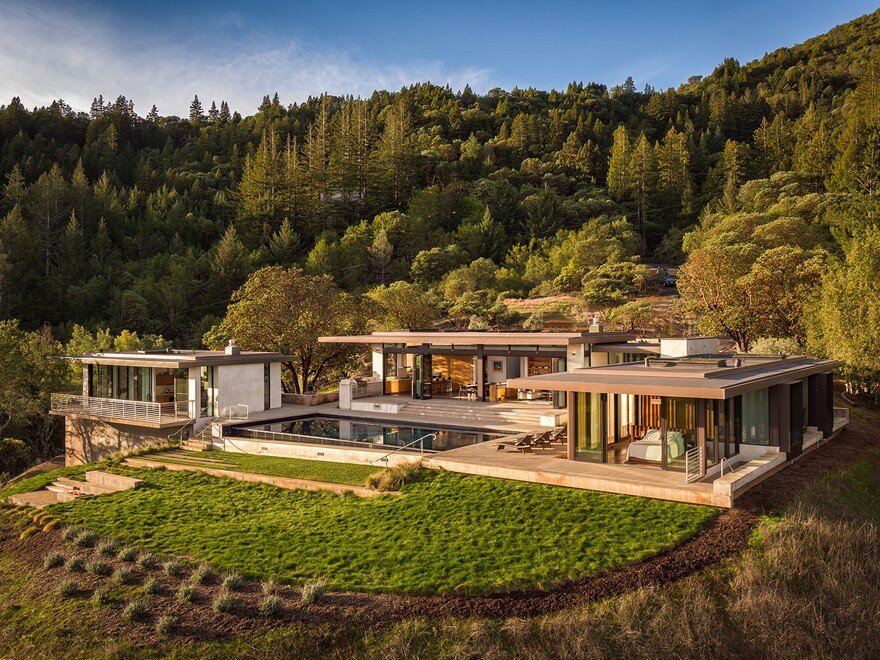
Cao Family Compound.
Legends and Anecdotes
One of the most captivating legends associated with the Cao Family Compound is that of a golden clock shaped like a locomotive, a gift from Empress Dowager Cixi. During a tumultuous time of political upheaval, the Empress borrowed a significant sum from the Cao family to secure her escape from Beijing. In gratitude, she presented this remarkable timepiece to them, which not only serves as a symbol of the family’s wealth but also as a reminder of their pivotal role in Chinese history.
Additionally, the compound is dotted with inscriptions and artifacts that reveal the family’s commitment to philanthropy and community—a legacy that resonates deeply within the local culture. These elements are not merely historical footnotes but living testimonies to the family’s enduring influence.
Conclusion
The Cao Family Compound is more than just an architectural wonder; it is a vibrant historical narrative that weaves together commerce, culture, and familial devotion. As you explore its courtyards and admire its treasures, you are invited to step back in time, absorbing the rich stories that have shaped this extraordinary residence. Engaging with the Cao family’s legacy offers international travelers an unparalleled opportunity to connect with the essence of Chinese culture and history, making a visit to this magnificent compound an unforgettable experience.

Cao Family Compound.
Main Highlights: What You Absolutely Can’t Miss
Discovering the Splendor of the Cao Family Compound
When exploring the rich tapestry of Chinese history and culture, the Cao Family Compound stands as a testament to the opulence of the Shanxi merchant class during the late Qing Dynasty. Nestled in Beiguang Village, just a short drive from the ancient city of Pingyao, this remarkable estate is a must-visit for anyone seeking to uncover the stories of wealth, power, and architectural grandeur.
Architectural Elegance
As you approach the compound, the first thing that strikes you is its noble yet understated design. Spanning over 10,638 square meters, the compound is composed of three expansive courtyards interconnected by a stunning arrangement of 277 rooms. The architectural style reflects a blend of Ming and Qing Dynasty aesthetics, characterized by tiered buildings that rise to an impressive height of 17 meters.
- Sanduo Hall: The centerpiece of the compound, this hall is not only a grand architectural feat but also steeped in cultural significance. Its name translates to “Three More,” symbolizing wishes for more good fortune, longevity, and children—an essential aspect of traditional Chinese values.
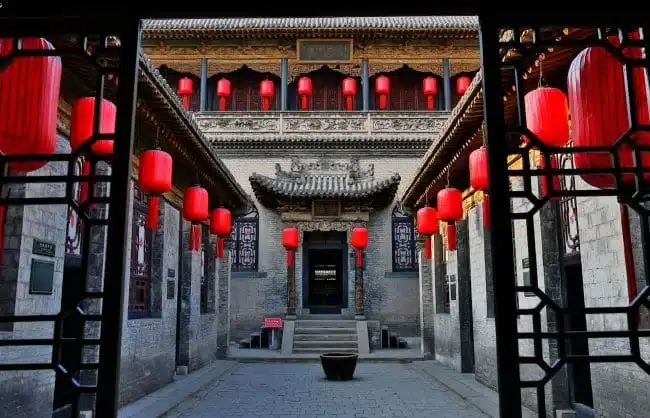
Cao Family Compound.
Rich Cultural Relics
Inside the compound, visitors will find a treasure trove of cultural relics that narrate the illustrious history of the Cao family. Here are some highlights not to be missed:
-
Ming and Qing Dynasty Furniture: The compound houses over 400 pieces of exquisite furniture, including an enormous folding screen adorned with 92 pieces of precious natural marble, and an intricately carved shell mirror that reflects different colors based on the viewer’s angle—each hue carrying auspicious meanings.
-
Golden Clock: A true national treasure, this Qing Dynasty clock is shaped like a locomotive and was gifted to the Cao family by Empress Dowager Cixi as a token of gratitude after they lent her funds during a tumultuous time. Weighing approximately 42.25 kilograms, it is not only a stunning piece of craftsmanship but also a fascinating historical artifact.
-
Porcelain Collection: The porcelain room boasts nearly 2,000 pieces of stoneware, dating back to the Ming and Qing Dynasties, offering insights into the artistic achievements of that era.
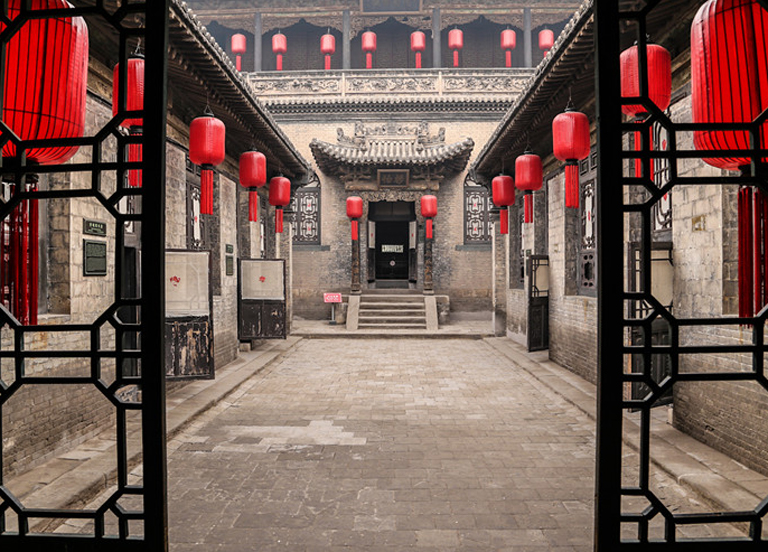
Cao Family Compound.
A Journey Through Time
Walking through the Cao Family Compound is akin to stepping back in time. The layout and design of the courtyards invite visitors to envision the vibrant life that once flourished within these walls. The atmosphere is enhanced by the carefully curated displays of art and artifacts, each telling a unique story of the family’s rise and eventual decline.
-
Art Gallery: The walls are adorned with paintings and calligraphy that not only beautify the space but also serve as a narrative of the family’s legacy.
-
Soundscapes: Subtle background music and informative plaques enrich the experience, ensuring that visitors leave with a deeper understanding of the Cao family’s contributions to Chinese commerce and culture.
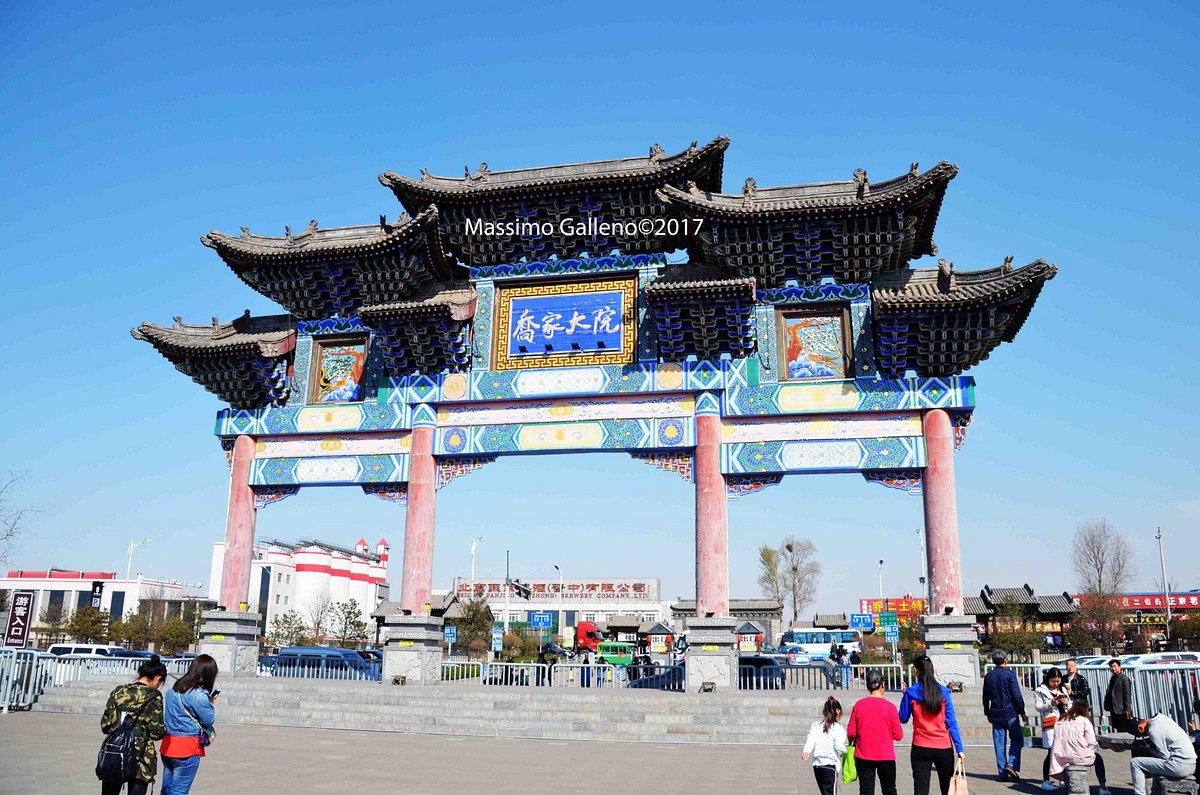
Cao Family Compound.
Visiting Information
To make the most of your visit to the Cao Family Compound, plan your trip as follows:
-
Location: The compound is located about 5 kilometers southwest of Taigu County, approximately 45 kilometers from Pingyao Ancient City.
-
Getting There: Take a bullet train from Taiyuan South Railway Station to Taigu West (about 30 minutes, CNY 14.5 for a second-class seat), then transfer to bus T05 and T06 to reach the compound.
-
Entrance Fee: CNY 72 from April to October; CNY 60 from November to March.
-
Opening Hours: 8:00 AM to 6:30 PM.

Cao Family Compound.
Conclusion
The Cao Family Compound is not merely an architectural marvel; it is a living museum that encapsulates the grandeur of a bygone era. Whether you are an aficionado of history, architecture, or culture, this compound offers a compelling glimpse into the life of one of Shanxi’s most influential families. Don’t miss the opportunity to explore this extraordinary site and immerse yourself in the stories etched within its walls.
Planning Your Visit: A Practical Guide
Exploring the Cao Family Compound: A Practical Guide for Travelers
The Cao Family Compound (曹家大院), a stunning historical site located in Shanxi Province, offers a remarkable glimpse into the life of one of China’s wealthiest merchant families during the Qing Dynasty. As you plan your visit, here’s everything you need to know to make the most of your experience.

Cao Family Compound.
Getting There
By Train:
– Start your journey at Taiyuan South Railway Station. Board a bullet train to Taigu West Station, which takes about 30 minutes and costs approximately CNY 14.5 for a second-class ticket.
By Bus:
– Upon arrival at Taigu West, take bus T05 to Wenhua Guangchang, then transfer to bus T06 heading to Sanduotang, the stop for the Cao Family Compound.
Location
The Cao Family Compound is located in Beiguang Village, around 5 kilometers (3.1 miles) southwest of Taigu County and approximately 45 kilometers (28 miles) northeast of Pingyao Ancient City. Its tranquil setting away from bustling roads adds to its charm, making it a perfect escape into history.
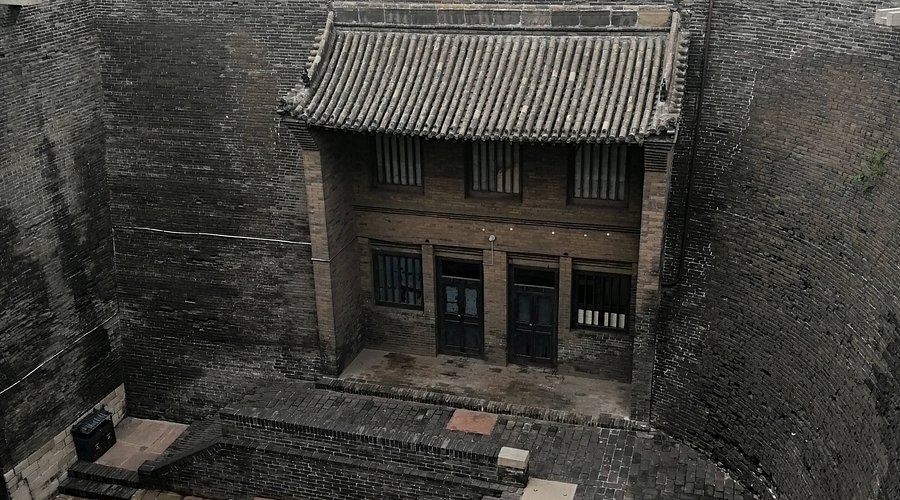
Cao Family Compound.
Entrance Fees and Hours
- Entrance Fee:
- April to October: CNY 72
-
November to March: CNY 60
-
Opening Hours:
- Daily from 8:00 AM to 6:30 PM
What to See
The Cao Family Compound spans an impressive 10,638 square meters (about 12,723 square yards) and features three large courtyards connected by 17-meter-tall buildings housing a total of 277 rooms. Here are some highlights:
- Sanduo Hall:
-
Known for its noble yet simple architecture, Sanduo Hall embodies the essence of Ming and Qing Dynasty styles. The name “Sanduo” translates to “three mores,” symbolizing wishes for more fortune, longevity, and children.
-
Cultural Relics:
-
The compound houses an extensive collection of artifacts including:
- A Golden Clock: A Qing Dynasty treasure gifted to the Cao family by Empress Dowager Cixi, notable for its unique locomotive shape.
- Ming and Qing Dynasty Furniture: Over 400 exquisite pieces, including a monumental folding screen adorned with natural marble.
- Porcelain Collection: Nearly 2,000 pieces of stoneware, showcasing the craftsmanship of the era.
-
Art and Exhibitions:
- The compound’s exhibitions include hundreds of artworks, photographs, and crafts that narrate the story of the Cao family’s rise and fall in wealth and influence.
Tips for Your Visit
-
Guided Tours: Consider hiring a guide or joining a group tour to fully appreciate the rich history and stories behind the artifacts and architecture.
-
Photography: The stunning architecture and well-preserved artifacts make for excellent photography opportunities, so don’t forget your camera!
-
Timing Your Visit: To avoid crowds, visit early in the morning or late in the afternoon.
-
Nearby Attractions: After visiting the Cao Family Compound, explore Pingyao Ancient City, where you can find additional historical sites such as the Ancient City Wall and the Confucius Temple.
Final Thoughts
The Cao Family Compound is not just a historical site; it’s a portal into the grandeur of China’s mercantile past. With its rich history, stunning architecture, and cultural treasures, your visit promises to be both enlightening and memorable. Dive into the stories of the past and witness the elegance of traditional Chinese architecture that has stood the test of time. Enjoy your journey into the heart of Shanxi’s history!
Tickets: Prices, Booking, and Tips
When planning your visit to the Cao Family Compound, it’s essential to prepare for both the journey and the experience itself. Here’s everything you need to know about ticket prices, booking options, and helpful tips to make your visit both enjoyable and enriching.
Ticket Prices
The entrance fees to the Cao Family Compound vary by season:
- April to October: CNY 72 (approximately USD 10)
- November to March: CNY 60 (approximately USD 8.50)
Opening Hours
The Cao Family Compound welcomes visitors every day from 8:00 AM to 6:30 PM. It’s advisable to arrive early to fully appreciate the sights and avoid the crowds.
Booking Your Tickets
Tickets can be purchased directly at the entrance. However, during peak tourist seasons, it may be beneficial to book in advance to ensure availability. Some online platforms may offer advance booking options, but it’s best to check for the most current booking methods closer to your travel date.
Getting There
To reach the Cao Family Compound from major cities like Taiyuan or Pingyao, consider the following travel options:
- From Taiyuan:
- Take a bullet train from Taiyuan South Railway Station to Taigu West Station (approximately 30 minutes, costing around CNY 14.5 for a second-class seat).
-
Upon arrival, catch bus T05 to Wenhua Guangchang, then transfer to bus T06 to Sanduotang (Cao Family Compound).
-
From Pingyao:
- The compound is about 45 kilometers northeast of Pingyao Ancient City. You can hire a taxi for convenience, or use local public transport options.
Tips for Your Visit
-
Explore Early: Arriving early in the morning helps you avoid the busiest times and allows for a more leisurely exploration of the compound’s architecture and exhibits.
-
Guided Tours: Consider joining a guided tour or hiring a local guide. Their insights into the intricate history and architecture can greatly enhance your understanding and appreciation of the Cao Family’s legacy.
-
Photography: Don’t forget your camera! The compound is a photographer’s dream, with stunning courtyards and intricate architectural details. Early morning light can provide the best conditions for capturing the essence of this historical site.
-
Cultural Insights: Take time to absorb the cultural relics displayed within the compound. The furniture exhibitions and historical artifacts will provide a glimpse into the opulent lifestyle of the Cao family during the late Qing Dynasty.
-
Plan for Time: Allocate at least 2-3 hours for your visit. With 277 rooms and multiple courtyards to explore, there’s much to see and learn.
By following these guidelines, your visit to the Cao Family Compound will be both memorable and enlightening, offering a deep dive into the rich tapestry of Chinese history and culture. Enjoy your journey through time!
How to Get There: A Complete Transportation Guide
Getting to the Cao Family Compound
Visiting the Cao Family Compound in Shanxi Province offers an incredible opportunity to delve into the rich history and culture of ancient Chinese commerce. To ensure a smooth journey to this architectural gem, here is a comprehensive guide on transportation options.
Starting Your Journey
Location: The Cao Family Compound is located in Beiguang Village, approximately 5 kilometers (3.1 miles) southwest of Taigu County in Jinzhong City, and about 45 kilometers (28 miles) northeast of the historic Pingyao Ancient City.
By Train
- From Taiyuan:
- Begin your journey at the Taiyuan South Railway Station.
- Board a bullet train heading to Taigu West Station.
- Duration: Approximately 30 minutes.
-
Cost: Around CNY 14.5 for a second-class seat.
-
From Pingyao:
- If you are staying in Pingyao, you can also take a train to Taigu West. Check the schedule for the best departure times.
By Bus from Taigu
Upon arrival at Taigu West Station, your next step involves taking public transportation to the Cao Family Compound:
- Bus T05:
-
Take bus T05 from Taigu West Station to Wenhua Guangchang.
-
Transfer to Bus T06:
-
At Wenhua Guangchang, transfer to bus T06 heading towards Sanduotang (the stop for the Cao Family Compound).
-
Final Destination:
- The bus will drop you off near the entrance of the Cao Family Compound.
Alternative Transportation Options
-
Taxi: For convenience, especially if you’re traveling in a group or with family, consider taking a taxi directly from Taigu West Station to the compound. The taxi ride typically takes around 15-20 minutes and may cost approximately CNY 30-50 depending on traffic.
-
Private Car Hire: If you prefer a more personalized experience or plan to visit several attractions in the area, renting a car or hiring a private driver could be a worthwhile investment.
Entrance Fee and Opening Hours
- Entrance Fee:
- From April to October: CNY 72
-
From November to March: CNY 60
-
Opening Hours:
- The compound is open daily from 8:00 AM to 6:30 PM.
Tips for a Smooth Visit
- Plan Ahead: Always check the latest train and bus schedules ahead of your visit, as they may vary seasonally.
- Carry Cash: While many places in China are becoming cashless, it’s wise to have some cash on hand for bus fares and entrance fees.
- Language: If you do not speak Chinese, consider downloading a translation app to help communicate with local transportation staff.
With this guide, you are now equipped to make the most of your trip to the Cao Family Compound. Enjoy your journey back in time to the opulent world of the Cao family and the storied history of Shanxi merchants!
Local Cuisine and Accommodation Nearby
When visiting the Cao Family Compound, immersing yourself in the local cuisine and finding the right accommodation can significantly enhance your experience of this historical gem in Shanxi Province. Here are some excellent options to consider.
Savor Local Flavors
Shanxi cuisine is renowned for its unique flavors, with a strong emphasis on vinegar, noodles, and hearty dishes that reflect the province’s rich agricultural heritage. Here are a few must-try dishes and where to find them:
-
Shanxi Knife-cut Noodles (Dao Xiao Mian): A regional specialty, these hand-cut noodles are often served in a rich broth with various toppings. Head to Zhang’s Noodle House in Pingyao for an authentic experience.
-
Vinegar Hot Pot: Known for its tangy flavor, this hot pot uses Shanxi’s famous aged vinegar. You can enjoy this dish at Pingyao Old Town Hot Pot located near the city center, where you can indulge in a variety of fresh ingredients.
-
Yangrou Paomo (Lamb Stew with Bread): This dish consists of shredded bread soaked in a flavorful lamb stew. Try it at Jinzhong Yangrou Paomo Restaurant, just a short ride from the compound.
-
Fenjiu: Don’t leave without sampling this traditional Shanxi liquor, known for its fragrant aroma and smooth taste. Visit Cao Family Brewery for a tasting experience paired with local snacks.
Where to Stay
Choosing the right accommodation can enhance your cultural immersion while ensuring comfort. Here are some recommended places near the Cao Family Compound:
-
Pingyao Yunjin Hotel: Located within the ancient city walls, this hotel combines modern comfort with traditional Chinese architecture. It’s ideal for travelers wanting to be close to major attractions, including the Cao Family Compound. The hotel also offers a delicious breakfast featuring local dishes.
-
Cao Family Courtyard Hotel: Just a stone’s throw from the compound, this charming hotel provides a unique opportunity to stay in a traditional courtyard setting. The decor reflects the historical significance of the area, and the staff is known for their hospitality.
-
Pingyao Harmony Guesthouse: Situated in a quiet part of Pingyao, this guesthouse provides a peaceful retreat after a day of exploring. The friendly owners offer guided tours of the area, including the Cao Family Compound.
-
Wang Family Compound Hotel: If you wish to experience another magnificent residence, consider staying at this hotel located near the Wang Family Compound. It offers spacious rooms and is an excellent base for exploring both the Wang and Cao Family Compounds.
Final Thoughts
Exploring the Cao Family Compound is not just about admiring its architectural beauty; it’s also an opportunity to delve into the culinary delights and hospitality of Shanxi. By indulging in local dishes and choosing accommodations that reflect the region’s rich heritage, you’ll create lasting memories of your journey through this fascinating part of China.
Frequently Asked Questions
Frequently Asked Questions about the Cao Family Compound
1. What is the Cao Family Compound?
The Cao Family Compound, also known as Sanduo Hall, is a historic residence located in Beiguang Village, near Taigu County, Shanxi Province. It was the home of the prosperous Cao family, influential merchants during the late Qing Dynasty. The compound showcases traditional Chinese architecture and offers insights into the family’s extensive legacy in commerce.
2. How do I get to the Cao Family Compound?
To reach the Cao Family Compound, take a bullet train from Taiyuan South Railway Station to Taigu West Station, which takes approximately 30 minutes. From Taigu West, you can take bus T05 to Wenhua Guangchang and transfer to bus T06 to Sanduotang, the nearest stop to the compound.
3. What are the opening hours and entrance fees?
The Cao Family Compound is open daily from 8:00 AM to 6:30 PM. The entrance fee varies by season: during the months of April to October, it costs CNY 72, while from November to March, it is CNY 60.
4. What can I expect to see inside the compound?
Inside the Cao Family Compound, visitors will find three grand courtyards connected by beautifully constructed buildings. The compound houses over 277 rooms and features a rich collection of cultural relics, including exquisite furniture, artworks, and national treasures like a golden clock gifted by Empress Dowager Cixi.
5. Is the Cao Family Compound suitable for children and families?
Yes, the Cao Family Compound is an excellent destination for families. Children will enjoy exploring the vast courtyards and learning about the history of the Cao family through engaging exhibits. The serene environment also makes it a pleasant outing for families.
6. Are there guided tours available?
While visitors can explore the compound independently, guided tours are often available and can enhance your experience by providing in-depth historical context and fascinating stories about the Cao family and the artifacts on display. It’s advisable to check in advance if guided tours are offered on the day of your visit.
7. What is the best time to visit the Cao Family Compound?
The best time to visit is during the spring (April to June) or autumn (September to October) when the weather is pleasant, and the scenery around the compound is particularly beautiful. However, visiting during the off-peak months can also provide a quieter experience.
8. Can I take photographs inside the compound?
Yes, photography is generally allowed within the Cao Family Compound, allowing you to capture the stunning architecture and artifacts. However, it’s advisable to be respectful of any signs indicating restrictions, especially in specific areas where flash photography may not be permitted.
Final Thoughts on Your Trip
As your journey through the Cao Family Compound comes to a close, reflect on the rich tapestry of history and culture that envelops this extraordinary site. This architectural marvel, steeped in the legacy of one of Shanxi’s most prosperous families, invites you to step back in time and witness the opulence and entrepreneurial spirit that defined an era.
A Journey Through Time
Visiting the Cao Family Compound offers more than just a glimpse into the past; it is an immersion into the lives of the merchants who once shaped Chinese commerce. Here are a few reasons why your visit is significant:
- Historical Significance: The Cao Family’s story is a testament to resilience and ambition, showcasing how a humble beginning in trade evolved into a vast empire with international ties.
- Architectural Beauty: The Compound’s harmonious blend of Ming and Qing styles creates a visual feast, with courtyards that echo the laughter and music of generations past.
- Cultural Riches: The treasures within, from exquisite furniture to rare artworks, narrate tales of fortune and misfortune, illuminating the complexities of family life and societal status during their heyday.
Reflect and Connect
As you walk through the grand courtyards and admire the intricate craftsmanship, take a moment to connect with the stories that linger in the air. Imagine the bustling life of merchants, the gatherings of family, and the celebrations that once filled these halls.
Final Reflections
Your visit to the Cao Family Compound is not just about seeing a historic site; it’s about understanding the cultural fabric of China and appreciating the contributions of its past. Whether you are an architecture enthusiast, a history buff, or simply a curious traveler, this experience is bound to resonate with you long after you leave.
Cherish the Experience
As you depart, carry with you the inspiration drawn from the Cao Family’s legacy. May it encourage you to explore further into the heart of Chinese history and culture, discovering the stories that lie within every corner of this remarkable nation. Until your next adventure, let the spirit of the Cao Family guide your travels, enriching your understanding of the world around you.